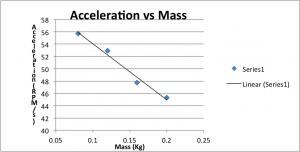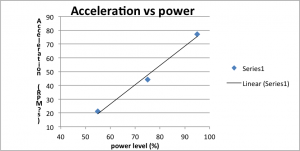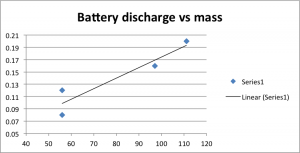In this lab we experienced Newton’s second law F = ma, the law of conservation of energy, velocity and acceleration, and power by using the Lego Mindstorm motor to lift up weights with a pulley.

First, exploring Newton’s 2nd law. Newton’s 2nd law states that acceleration is produced when a force acts on a mass. The greater the mass (of the object being accelerated) the greater the force needed (to accelerate the object). From the formula F = MA, we can calculate any unknown value as long as we have 2 know values. Below is a simple way to explain the law.
With that being explained, when we kept the power level (force) fixed and changed the mass by 40 g at a time for 3 turns in the experiment, we found out that the acceleration changes inversely proportional to the change of mass. In other words, the smaller the mass the faster the acceleration. A great clarification can be done by using the Excel with the values and graphing the results as shown below.

Units; Acceleration rpm/s (rotation per minute/ second). Mass kg (kilograms)
For the second part of exploring this law, we kept the mass fixed and changed the power level resulting in directly proportional changing in acceleration. Therefore, a= f/m has been verified by this following graph.

Second, exploring the Law of Conservation of energy. Energy in a system may take on various forms kinetic, potential, heat, or light for instance. The law states that energy can neither be created nor destroyed, therefor, the sum of all forms of energy in the system is a constant. For example, a pendulum is commonly used to demonstrate the law.
When the pendulum is pulled leftward, potential energy will be converted to kinetic energy as the to make the pendulum move rightward. The pendulum is going to keep swinging until all of the kinetic energy is converted back to potential energy. Therefore, potential energy PE= mgh where m is the mass, g is the acceleration of gravity, and h is the height.
The experiment we did was to determine the battery drainage as a function of mass. As we keep the power level fixed and change the mass, we can notice that the greater the mass the greater battery drainage as shown in the graph below. This is, because the battery energy gets converted to the potential energy of the mass.

Third, for the final experiment, we calculated the average of the power used by the motor in all the trials with the fixed mass and variable power level. The formula used for this calculation is power used= potential energy/time= mgh/time

In conclusion, in order to give the reader a bigger image of the experiments, below is the excel sheet with all the values.
| Speed(RPM) | battery discharge | Mass(kg) | power(%) | time(s) | acceleration(RPM/s) | g (m/s^2) | height(m) | mgh(j) | Power used(W) | |||||||||||
| 0 | 86.052632 | 0 | 111 | 0 | 0.2 | 0 | 75 | 0 | 1.9 | 0 | 45.290859 | 9.8 | 0.33 | 0.6468 | 0.340421053 | |||||
| 0 | 89.346161 | 0 | 97 | 0 | 0.16 | 0 | 75 | 0 | 1.871 | 0 | 47.753159 | 9.8 | 0.33 | 0.51744 | 0.27655799 | |||||
| 0 | 92.006901 | 0 | 56 | 0 | 0.12 | 0 | 75 | 0 | 1.739 | 0 | 52.907936 | 9.8 | 0.33 | 0.38808 | 0.223162737 | |||||
| 0 | 96.17613 | 0 | 56 | 0 | 0.08 | 0 | 75 | 0 | 1.726 | 0 | 55.721976 | 9.8 | 0.33 | 0.25872 | 0.149895713 | |||||
| 0 | 111.265005 | 0 | 84 | 0 | 0.2 | 0 | 95 | 0 | 1.444 | 0 | 77.053327 | 9.8 | 0.33 | 0.6468 | 0.447922438 | |||||
| 0 | 57.112996 | 0 | 55 | 0 | 0.2 | 0 | 55 | 0 | 2.711 | 0 | 21.067133 | 9.8 | 0.33 | 0.6468 | 0.238583549 | |||||
| 0 | 84.980923 | 0 | 83 | 0 | 0.2 | 0 | 75 | 0 | 1.922 | 0 | 44.21484 | 9.8 | ||||||||
This lab was very beneficial in a way that allowed us to analyse values and learn important laws of physics in general practically, which I personally always prefer.
References
http://easycalculation.com/physics/classical-physics/learn-potential.php
http://www.glogster.com/scuther/newton-s-second-law/g-6l1p2i7ggpcp8uq7ig08ga0
http://chemistry.tutorvista.com/inorganic-chemistry/law-of-conservation-of-mass.html
